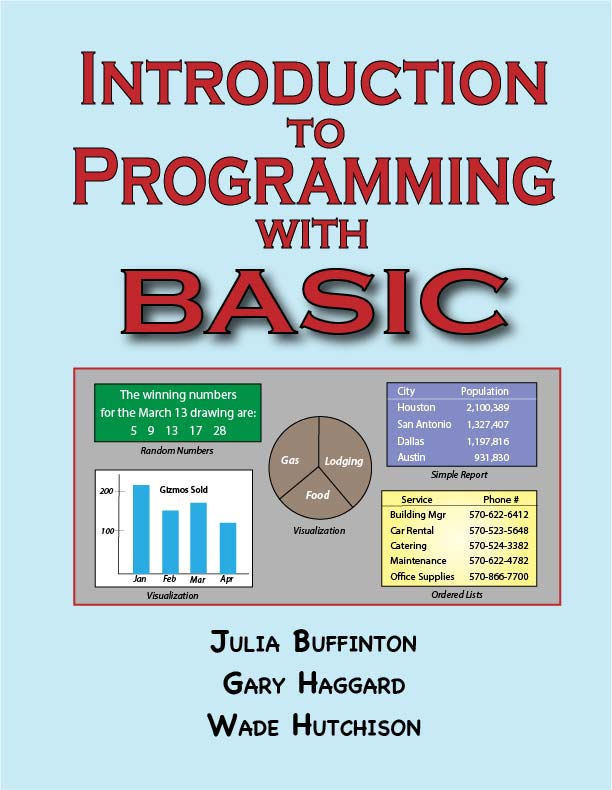Academic, Professional, Technical, Trade, Research Books & Journals
americanpress@flash.net • 617-247-0022 • 75 State Street #100 • Boston, MA 02109
Introduction to Programming with Basic
by JULIA BUFFINTON, GARY HAGGARD, WADE HUTCHISON
5th ed, 2018, 225 pages, $49.95
ISBN 978-0-89641-562-1
Basic has evolved into a programming language with an object-oriented option used for major applications. It is still an excellent choice for introducing the features a programming language has and how all of these features are used to solve real problems. The ideas of computation, logical tests, the repetition of blocks of code, the use of random numbers, graphics, and arrays are all presented in an accessible way. The chapters are designed to present the language features commonly used in algorithm development.
This text uses Visual Basic 6.0 as its language, but the downloadable Basic program at JustBasic.com could be used. When discussing macros, the Basic program built into Excel is used. The Excel version of Basic is part of the Excel program.
Each chapter has several features to aid the learning process. The On Your Own sections are short answer questions to help ensure the material presented is understood. The SYNTAX boxes area a way to highlight the syntactical aspects of commands for ready reference. The Putting It All Together sections are a collection of problems for the reader that use the features introduced in the chapter as well as ideas from previous chapters. The material is well-suited for independent and small group learning as well as classes in various settings where students are exploring what computing is all about.
CONTENTS
Chapter 1: Getting Started
- Procedure for Starting
- Printing the Program
- saving the Program
- Reloading the Program
- Exiting Basic
Chapter 2: Screen Output
- Programming Practices and Conventions
- The REM Statement
- the CLS Command
- The Print Command
- Print with a Semicolon
- Print with a Comma
- Positioning Output on the Screen
- Drawing Pictures
- Putting it All Together
Chapter 3: Input Values and Output Displays
- Data Type Values
- Variables
- Assignment Statements
- Dialog Boxes
- Displaying Values
- Numeric Values as Input
- Creating User-Friendly Output
- Putting It all Together
Chapter 4: Numeric Calculations
- Operations, Functions and Expressions
- Operation Hierarchy
- Subexpressions
- Built-in Functions
- Concatenation
- Formatting Output
- Putting It All Together
Chapter 5: Decision Making
- Simple Comparisons
- Numeric Comparisons
- Strings
- Character Represnetation
- Dictionary Ordering
- String Comparisons
- Conditional Statements
- Simple If-Blocks
- The Else Option
- Compound Condition If-block
- Multi-case If-Blocks
- Putting It All Together
Chapter 6: Branching
- Line Labels
- Unconditional Branching
- Repetition of Code
- Conditional Branching
- Repeating Blocks of Code
- Repetition of Number of Times
- Sentinels
- Prompt and Echo
- User Interrogation Technique
- Putting It All Together
Chapter 7: Repetition of Code
- The For...NextLoop
- The Step Parameter
- Program Applications
- Supply-Demand Curves
- Generalized Functionality
- Nested Loops
- DoWhile...Loop Construct
- While Loop and a Sentinel
- approximating a Solutiobn
- Putting It All Together
Chapter 8: Random Numbers
- The Rnd Function
- Using Randomize
- Coin Tossing
- Tossing a Biased Coin
- Die Rolling
- Scaling the Rnd Function
- A Simulation
- Putting It All Together
Chapter 9: Graphics
- Resolution and Color
- Coloring Pixels
- Drawing Lines
- Using the PSet Command to Draw a Line
- Using the Command Line
- Drawing Rectangles
- Drawing Circles
- Drawing Arcs
- Drawing Sectors
- Drawing Ellipses
- FullStyle and FullColor
- Drawing a Line Graph
- Drawing a Pie Chart
- Crawing a Histogram
- Putting It All Together
Chapter 10: 1-Dimensional Arrays
- Defining an Array
- The Syntax of Defining Arrays
- Assigning and Using Values in an Array
- Finding the Average and the Standard Deviation
- File Input
- File Output and EOF()
- Searching an Array
- Finding the Smallest Element in an Array
- File InputInterchanging Two elements in an Array
- Sorting an Array
- Finding a Distribution of Elements
- Parallel Arrays
- Inner Products of Vectors (optional)
- Drawing a Histogram
- Putting It all Together
Appendix A: Translating Language Suntax to Basic
Appendix B: Odd Solutions
Appendix C: Index
ABOUT THE AUTHORS ..
Julia Buffinton, Professor of Linguistics at the University of Maryland, currently works in Washington D.C. in the field of data analysis. Gary Haggard is a Professor of Department of Computer Science at Bucknell University while Wade Hutchison is a Developmental Engineer with the College of Engineering at Bucknell University. He uses Visual Basic to build applications with graphic use interfaces for undergraduate and researdch students.